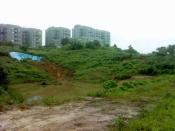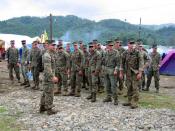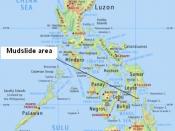Mass wasting is defined as the down slope movement of rock and regolith near the Earth's surface mainly due to the force of gravity. Rock slides and debris slides result when rocks or debris slide down a pre-existing surface, such as a bedding plane, foliation surface, or joint surface. On February 17, 2006 the Philippines was hit by landslides. In Southern Leyte mudslides destroyed the mountain village (Barangay) Guinsaugon. During schooltime between 9 a.m. and 10 a.m., an elementary school was completely buried under the mud layer of up to 10 meters thickness. All the 246 children and the 7 teachers were buried in a few seconds. It is reported that only one child and one adult woman have been rescued.The total loss of lives in Guinsaugon and buried under the mud is estimated to be at least 1000.
The disaster happened after ten days of heavy rainfall.
The rainfall dumped 27 inches of rain. Prof Dave Petley, professor at the International Landslide Centre, Durham University, agreed. "This sort of rainfall and landslide action in the Philippines at this time of year is quite unusual," he said, and may be tied to La Nina hurricane. Scientists but also survivors said that not only the weather, but also illegal logging on land above the village contributed to the disaster.
A minor earthquake (magnitude 2.3 on the Richer scale) shook the area, but scientists said it took place after the landslide. Probably there wasn't any relation between the landslide and the earthquake. The south eastern area of Leyte is forested with coconut trees where the disaster happened. These trees have shallow roots that can be dislodged after heavy rainsfalls rather easily, making the land unstable. In such areas landslides always will be a potential danger after days of heavy rainfall.


